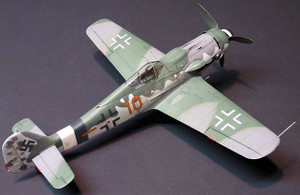
Tamiya #61095 Foke-Wulf Fw190 A-8 1/48
Highly detailed 1:48 scale assembly model kit of the WW2 German Focke-Wulf Fw190 A-8 / A-8 R2 Fighter.
The Focke-Wulf Fw190 was one of the Luftwaffe's best front-line fighters of WWII. Of all the different variants, the A-8 armed with four 20mm cannon and two 13mm machine guns was the most widely produced. A sub-variant of the A-8 was the R2, which had two of the 20mm cannons replaced by more powerful 30mm guns and added armor protection for its role in attacking the giant 4-engined Allied bombers.
The Fw 190 A-8 version entered production in February 1944 and continued to support the German Air Force until the end of the war, confronting the Allies B-24 and B-17 bombers over Germany.
This plastic kitset requires assembly, paints and glue to complete.
The Focke-Wulf Fw 190 Wurger (Shrike) was a German Second World War single-seat, single-engine fighter aircraft designed by Kurt Tank in the late 1930s. Powered by a radial engine, the 190 had ample power and was able to lift larger loads than its well-known counterpart, the Messerschmitt Bf 109. The 190 was used by the Luftwaffe in a wide variety of roles, including day fighter, fighter-bomber, ground-attack aircraft and, to a lesser degree, night fighter.
The Fw 190 A-8 entered production in February 1944, powered either by the standard BMW 801 D-2 or the 801Q (also known as 801TU). The 801Q/TU was a standard 801D with improved, thicker armour on the front annular cowling, which also incorporated the oil tank, upgraded from 6 mm (.24 in) on earlier models to 10 mm (.39 in). Changes introduced in the Fw 190 A-8 also included the C3-injection Erhöhte Notleistung emergency boost system to the fighter variant of the Fw 190 A (a similar system with less power had been fitted to some earlier Jabo variants of the 190 A), raising power to 1,980 PS (1,953 hp, 1,456 kW) for a short time. The Erhöhte Notleistung system operated by spraying additional fuel into the fuel/air mix, cooling it and allowing higher boost pressures to be run, but at the cost of much higher fuel consumption. From the A-8 on, Fw 190s could be fitted with a new paddle-bladed wooden propeller, easily identified by its wide blades with curved tips.
A new outwardly-bulged main canopy glazing format, more in the manner of a Malcolm hood rather than a bubble canopy, with greatly improved vision sideways and forward, had been developed for the F-2 ground attack model, but was often seen fitted at random on A-8s, F-8s and G-8s. The new canopy included a larger piece of head armour which was supported by reinforced bracing and a large fairing. A new internal fuel tank with a capacity of 115 L (30 US gal) was fitted behind the cockpit, which meant that the radio equipment had to be moved forward to just behind the pilot. Externally, a large round hatch was incorporated into the lower fuselage to enable the new tank to be installed, and the pilot's oxygen bottles were moved aft and positioned around this hatch. A fuel filler was added to the port side, below the rear canopy and a rectangular radio access hatch was added to starboard. Other changes included an ETC 501 underfuselage rack which was mounted on a lengthened carrier and moved 200 mm (8 in) further forward to help restore the centre of gravity of the aircraft. This fuselage would form the basis for all later variants of the Fw 190 and the Ta 152 series. The Morane whip aerial for the Y-Verfahren was fitted as standard under the port wing, just aft of the wheelwell. Nearly a dozen Rustsatze kits were made available for the A-8, including the famous A-8/R2 and A-8/R8 Sturmbock models.
The A-8/R2 replaced the outer wing 20 mm cannon with a 30 mm (1.18 in) MK 108 cannon. The A-8/R8 was similar, but fitted with heavy armour including 30 mm (1.18 in) canopy and windscreen armour and 5 mm ( in) cockpit armour. The A-8 was the most numerous of the Fw 190 As, with over 6,550 A-8 airframes produced from March 1944 to May 1945. A-8s were produced by at least eight factories during its lifetime.